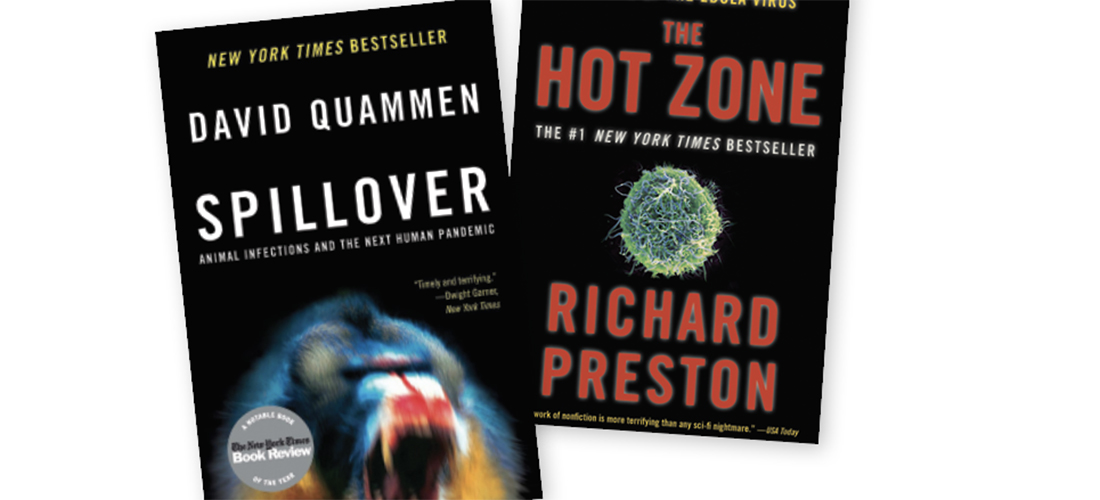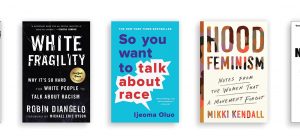
Going Viral
Shedding light on dark days
By Stephen E. Smith
In the mid-’90s, Richard Preston’s nonfiction The Hot Zone was a bestseller. Based on a 1989 outbreak of an Ebola-like strain of virus in Reston, Virginia, the horrors depicted in Preston’s book kept this reviewer awake at night. Even though the sickness was confined to monkeys imported for research purposes, it took an Army medical team clad in spacesuits to exterminate the infected primates.
With ample time to contemplate the predicament in which we now find ourselves, I did what reviewers do: I read, albeit belatedly, other books about pandemics. I downloaded Catharine Arnold’s Pandemic 1918: Eyewitness Accounts from the Greatest Medical Holocaust in Modern History, Sara Shah’s Tracking Contagions, from Cholera to Ebola and Beyond, Alfred Crosby’s America’s Forgotten Pandemic: The Influenza of 1918, and David Quammen’s Spillover: Animal Infections and the Next Human Pandemic (there are umpteen other equally enlightening volumes I haven’t had time to pursue), and I discovered in each book a blueprint for the COVID-19 pandemic — disturbingly precise roadmaps for events over which we might have managed a modicum of control on a worldwide, national and personal level had we taken to heart what history and science has to teach us.
If you’re interested in understanding the COVID-19 pandemic, Quammen’s 2016 Spillover is by far the most informative — and the scariest — study. He focuses on zoonotic diseases such as Ebola, AIDS, rabies, influenza and West Nile, infections that sicken animals and jump to humans. COVID-19, although not identified when Spillover was written, is a zoonotic that has escalated into a pandemic via human-to-human transmission, and Quammen makes it possible for the layman to comprehend the viral dynamic at work. He explains in straightforward terms how global travel and exploding world populations make it possible for a virus such as COVID-19 to spread rapidly. We tend to view the spread of such a virus as an independent misfortune that happened to us (how else would a nonscientist see it?), but “That’s a passive, almost stoical way of viewing them,” he writes. “It’s also the wrong way,” making us susceptible to anecdotal testimony and false cures that might be harmful.
Quammen says that emerging diseases are the result of two forms of crisis on the planet — ecological and medical. “Human-caused ecological pressures and disruption are bringing animal pathogens ever more into contact with human populations, while human technology and behavior are spreading pathogens ever more widely,” Quammen writes. Logging, road building, slash-and-burn agriculture, the consumption of wild animals, mineral extraction, urban settlement, chemical pollution, nutrient runoff into oceans — most of what we call “civilizing” incursions upon the natural world — destroy the ecosystem. This destruction releases viruses, bacteria, fungi, protists and other parasites embedded in natural relationships that limit their geographical range. “When the trees fall and the native animals are slaughtered, the native germs fly like dust from a demolished warehouse.”
In 2012 Quammen asked this straightforward question, “Will the Next Big One be caused by a virus? Will the Next Big One come out of the rain forest or a market in China? Will the Next Big One kill 30 or 40 million people?”
If we can’t predict the next pandemic, says Quammen, we can remain vigilant, we can monitor worldwide transmission, and take precautions. Argue as we may about how and why we got here, the fact remains we find ourselves in a frightening moment whose ramifications must be faced head on. Spillover allows the reader to do just that.
As thorough and graphic as the above-mentioned volumes are, they don’t truly immerse the reader in the personal misery visited upon the Spanish flu generation or on those of us suffering the most extreme ravages of COVID-19. But there are books of fiction — doses of focused reality — that do just that, books I’d read 50 years ago.
The first is Katherine Anne Porter’s 1939 Pale Horse, Pale Rider, a collection of three “short novels.” Told in the third person, the title story lulls the reader into the complacency of daily life — until the influenza sweeps up and almost kills the youthful protagonist. Porter’s description is worth reading in full, but here’s a sample:
“Pain returned, a terrible compelling pain running through her veins like heavy fire, the stench of corruption filled her nostrils, the sweetish sickening smell of rotting flesh and pus; she opened her eyes and saw pale light through a coarse white cloth over her face, knew that the smell of death was in her own body, and struggled to lift her hand.”
Porter suffered bouts of influenza at least three times in her life, so she writes from an acuity borne of experience, and she’s careful to impress upon the reader that we are all cursed with the conviction that nothing terrible can happen to us . . . until it happens.
If Porter captures the suffering endured by a victim of the pandemic, North Carolina’s Thomas Wolfe wrenches the reader’s soul when conveying the agony of watching a loved one die from the Spanish flu in Look Homeward, Angel. With Wolfe, the reader is always in danger of being consumed by his excessive wordiness, but it’s that verbosity that’s effective in conveying a terrible reality. Again, the writer’s words are worth reading in full, but here’s an excerpt:
“The rattling in the wasted body, which seemed for hours to have given over to death all of life that is worth saving, had now ceased. The body appeared to grow rigid before them. . . But suddenly, marvelously, as if his resurrection and rebirth had come upon him, Ben drew upon the air in a long and powerful respiration; his gray eyes opened. . . casting the fierce sword of his glance with utter and final comprehension upon the room haunted with its gray pageantry of cheap loves and dull consciences and on all those uncertain mummers of waste and confusion fading now from the bright window of his eyes, he passed instantly, scornfully and unafraid, as he had lived, into the shades of death.”
Books about death and disease don’t make for cheerful reading, but understanding the pandemic is better than succumbing to its ravages or losing a loved one to COVID-19. Wear a mask, wash your hands, social distance — and read wisely. OH
Stephen E. Smith is a retired professor and the author of seven books of poetry and prose. He’s the recipient of the Poetry Northwest Young Poet’s Prize, the Zoe Kincaid Brockman Prize for poetry and four North Carolina Press Awards.





